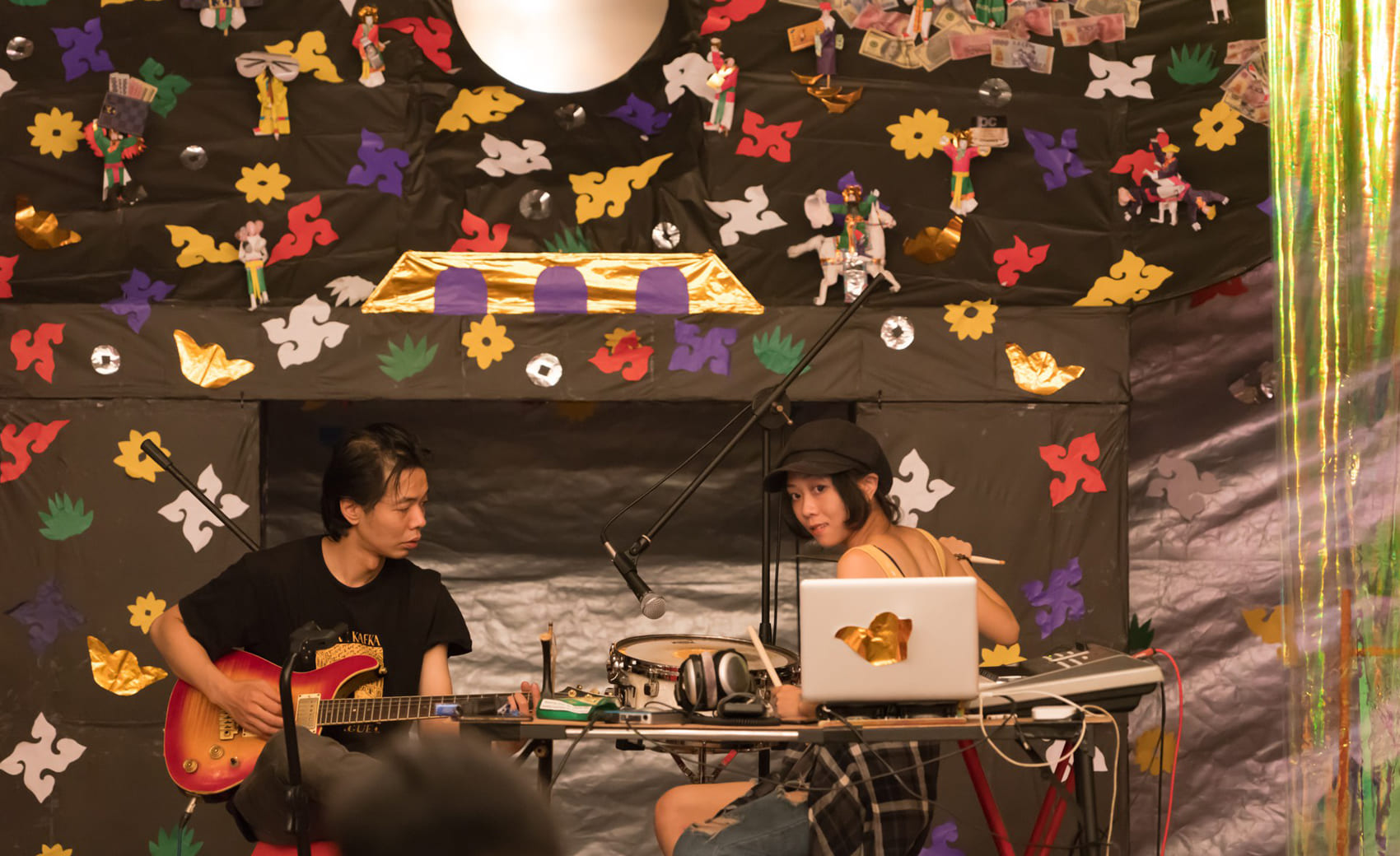歷時兩年多深掘民間文化的新作,嘗試在馬戲雜耍中融入臺灣喪葬儀式特有的「弄饒」技藝,從探索中表現出兼具傳統與當代的雜技語彙和身體特性。弄轉鐃鈸與火球等絕技,在殯葬儀式中往往扮演著轉化悲喜、娛靈娛人的功能,導演將其物件象徵和儀式意義加以提煉嫁接到現代表演,且在兩廳院外搭起俗豔的臺式帳篷,點綴新興糊紙文化色彩斑斕的紙紮藝術,請來實際執業的師公加入演出、增添詼諧笑料,搭配混編流暢的樂種雜匯活絡現場,邀請觀眾飲酒觀看,一同感受生死臨界、冷熱交替的氛圍節奏,觀看生命的過眼即逝。透過融合科儀神聖和生活現場的雜演狂歡,將集體悲傷從沈重此岸擺渡到曼波輕盈的彼岸,展現另類超渡的療癒作用。
This new work created after two years of field research about folk culture attempts to incorporate the distinctive “Nong Nao” acrobatic performance typically performed in Taiwanese funeral rites into circus performance, displaying an acrobatic language and body characteristics informed by both the traditional and contemporary spirit. The mesmerizing performance of crotales (small cymbal) and fireball in funeral rites often play a role of diluting the sorrow with laughter, entertaining the spirits as well as the living. The director refined the symbolism of objects and the implications of rituals before integrating them into the modern performance. A tri-colored Taiwanese-style tent was put up outside the National Theatre & Concert Hall, decorated with the multi-colored paper craftwork of Hsin Hsin Joss Paper. In addition, real practicing shamans were invited to join the performance, bringing a mélange of humor and fluidly arranged music that enlivened the live scene. The audience sipped wine while enjoying the performance, taking part in a liminal atmosphere with alternating somber and boisterous rhythms to witness the transitioning of the transient life. Blending religious rituals and live acrobatic performance, the work ferried the melancholic burden of collective sorrow to the other shore with a lighthearted mambo, unfolding an alternative soul-liberating ceremony with much therapeutic effect.
圓劇團
由林正宗與陳星樂等人共同成立於2016年。團名取「圓」無邊界和無限循環生命結構的意象,自許成為自由的場域,多元面向地伸展觸探,尋求當代馬戲藝術的實驗與探索,同時以行動連結常民文化,讓馬戲自然地呈現出有機的人性與溫度。團名之「圓」,亦有邀請聚首、分享當代馬戲藝術之意,期望藉由劇團和劇作,讓藝術家與觀眾彼此連結、激盪思考,以詩意的力量,產生對當代社會的哲思。
Thunar Circus Founded by Lin Cheng-Tsung, Valentin Lechat and others in 2016, the theatre company’s name, Thunar (THe UNited ARtists) signals the boundless and infinite cycle of life, and aims to serve as a free site that extends diversely in the experimentation and exploration of contemporary circus art. Meanwhile, Thunar Circus connects with folk culture through actions, naturally introducing organic humanity and warmth into circus performance. The theatre company’s name also indicates to unite and share the art of contemporary circus art, hoping to bring together artists and audience through the theatre company and their performances while provoking new ideas to generate contemporary social philosophical thinking with the poetic power.
邱坤良
楊士賢
周伶芝
林正宗
陳長志
黃懷德
張國韋
黃思農、曾韻方
江佶洋
蔡浩天
新興糊紙文化
林午銅鑼、詹介卿
詹介卿、彰化永靖詹家民俗特技團、桃園許厝港許家班振德壇
張景翔
羅文岑
林文尹、温其偉、林乘寬、郭爵愷、許偉倫、許偉翔(桃園許厝港許家班振德壇)
王嫈綠
林春輝
陳長志、林育全
國家兩廳院-戲劇院 生活廣場
關鍵字
- 裝置展覽
- 馬戲
- 民間雜技
- 喪葬科儀表演
- 帳篷
藝術家談作品
將此民間雜技與當代馬戲交錯並置,藉由身體的演繹活化,找到延續文化記憶的可能,同時傳達一種世事無常、流轉循環的生命觀。
採訪及文字整理/吳家瑀
「弄鐃」是傳統喪葬科儀裡的技藝表演,過程即興趣味,不僅是撫慰亡靈的儀式,更可轉渡悲喜,緩解生者哀慟。圓劇團《悲傷ㄟ曼波》將此民間雜技與當代馬戲交錯並置,藉由身體的演繹活化,找到延續文化記憶的可能,同時傳達一種世事無常、流轉循環的生命觀。
弄鐃文化,本土馬戲
「除了學校學的東西,還有甚麼是更有機、更生活的,跟我自己的傳統經驗相關的?」2016年圓劇團創立至今,導演林正宗不斷追尋當代馬戲雜技可依附之本土文化,發現行將消逝的文化傳統裡,其實「有很多很時尚、很現代的語彙」,讓他能夠「看到更深的東西」,因此決定以民藝、以弄鐃,解放刻板的馬戲形式。2016年《如果你還在》、2017年《噶哈巫!斷語?》以竹子、竹藝為元素,2019年進一步將弄鐃帶進作品裡。
「弄鐃這個東西,我小時候看過一次。」林正宗回想首度觀看弄鐃表演,彼時隔壁阿婆家辦喪事,現場卻有猴子戲耍特技、也有人跳火圈啣椅子。「他們常常把一張椅子咬起來之後,還能變化出一些東西,用吉祥話去講,說甚麼『我現在咬的不是椅條,是金條喔』。」弄鐃科儀中的即興發揮,如轉換角色身份,或是就地取材,都讓林正宗覺得「很活」、「既寫實又魔幻」,因而他也在《悲傷ㄟ曼波》裡面,用身體和道具去產生這樣的時刻。
雜技的身體,科儀的匯變
「竹子對我來說,有些不可掌握的狀態,以及它還有一種危險的特色。所以我的每個作品裡都有竹子,包括《悲傷ㄟ曼波》,撐起鐃鈸的工具、轉鐃鈸的就是竹子」,林正宗喜歡古老事物,卻不是刻意為舊而舊,而是發掘有益發展馬戲身體語彙的元素,對於竹子和弄鐃科儀的追尋便是如此。
近身觀察弄鐃身形,使《悲傷ㄟ曼波》達成當代馬戲與傳統雜技的身體和諧,跨域合作則為林正宗提供更多視角,將劇作格局打開。比如與新興糊紙文化的藝術家張徐展是首次合作,糊紙和弄鐃「都與生命科儀相連」,引發張徐展聯想,借用牽亡儀式中的紙糊法器「水藏」,疊成演出篷內的兩側柱體,「鐃鈸是圓的,它一直在轉,就像一種輪轉,他由此想到糊紙也有圓形的、循環輪轉的東西。那牽水藏是撥下去就會轉,往生者就會離開它痛苦所在,往西方極樂世界昇華。」
視覺藝術家陳長志也援引西洋動畫裝置「費納奇鏡」來表現鐃鈸轉傷悲於圓滿之意,再以攝影蒙太奇拼貼火轉鐃鈸與旋轉木馬影像,呼應弄鐃時空既是行喪又似樂園的曖昧狀態;而現場音樂作為替演員帶戲的動力,「音樂一奏下去,演員就有點『茫』的感覺。這種『茫』就是《悲傷ㄟ曼波》想要的。」林正宗說,黃思農很能掌握弄鐃音樂的雜燴感:「他的音樂就很雜,有衝突、有浪漫、有很孔鏘的東西。」此次合作對象雖然對主題理解各有觀點方式,彼此念頭拋接、協調溝通,創意終得馳騁發揮。
與悲傷共舞,一同搖擺人生
「『悲傷ㄟ曼波』這個名稱是在看弄鐃時想到的。」林正宗說,看弄鐃就像洗三溫暖,上一秒師公還神色嚴肅,下一秒音樂轉場,馬上開始表演搞笑,冷熱交替,對他來說很是衝突。林正宗覺得這種二元對立其實也是呼應人生,生死課題,往往來得猝不及防,對於這樣的劇變,只能面對。而這也正是林正宗覺得弄鐃之所以有其存在必要:「它使我們心靈得到一些平衡慰藉,也得到一些我們原本想像不到的期待,所以弄鐃雖是表演給亡者看,也是表演給生者看」。弄鐃在悲喜跌宕間撫慰生者,所以才說:「弄鐃就像和悲傷的人一起跳舞」。
然而,這樣的文化正在消逝。「過去弄鐃很重要的意義在於召喚和驅離,鐃鈸聲一出,能召喚亡者,也驅走不乾淨的東西,讓亡者路上好走。但現在反而是鐃鐃被文明社會驅離。所以『驅離』在這裡有其現代性。這是不一樣的驅離,它能驅離,然後它也被驅離。」林正宗在田調過程中除看到技藝沒落,也看到與之相關的工藝凋零,回想起當初帶演員找詹介卿師傅學弄鐃,弄鐃鐃鈸需特別訂製,偏偏老師傅又少,最後才找到宜蘭的林午銅鑼一起設計製作。因此,林正宗在戲的最後一幕,才以漸遠散去的鐃鈸聲火,隱喻傳統技藝的消亡命運。
《悲傷ㄟ曼波》承載弄鐃文化,說出生命是一場悲喜歌舞、搖擺人間。戲末的火鐃不停轉至散盡,也轉出光暗共存、片刻消逝的世間意象,而即將失傳的民間技藝,也在與現代馬戲融合轉化、度脫紛繁愁緒中,找到其再現於當代的意義。
評審談作品
既是生死臨界的走江湖特技雜耍,也是台式黑色幽默。
在帆布搭棚的劇場空間裡,既不是婚喪,卻有喜慶氛圍,沒有那麼悲傷,因為有著雜技的曼波。圓劇團聚合了文化人類學、劇場、道場、雜技、音樂等多方菁英,戲仿道教科儀的身體圖像與引渡亡魂的表演文化,運用了殯喪、弄鐃、電子琴、爵士鼓、嗩吶等元素,展現詭異狂歡、群魔亂舞的異怪身體,夾雜插科打諢,憂傷與歡樂齊飛,五味雜陳,難以形容。既是生死臨界的走江湖特技雜耍,也是台式黑色幽默。 (主筆/于善祿)
In the theatrical space under a canvas tent, the joyous, festive atmosphere does not come from weddings or funerals, and the melancholy seems diluted by the jugglery of mambo. Bringing together elites of cultural anthropology, theatre, dojo, jugglery and music, Thunar Circus parodies the physical diagrams in Taoist rituals and the performance culture of spirit guiding. The work uses elements such as funeral, jugglery, electronic piano, jazz drumming and suona to reveal grotesque bodies in a strange, bacchanal, chaotic setting informed by nonsensical comedy mixing sorrow and laughter as well as a range of emotions, defying any definite descriptions. It is folk stunts and jugglery in a liminal state between life and death as well as the embodiment of typical Taiwanese black humor. (Commentator: YU Shan-Lu)








